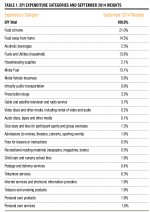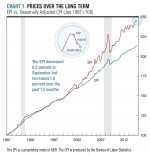Everyday Prices Slow in September
For the third straight month the price of all grades of gasoline decreased: regular decreased 2.2 percent; mid-grade decreased 1.9 percent, and premium decreased 2.1 percent. The price of home heating oil dropped 2.1 percent while utility bills were restrained by a 1 percent decrease in the price of electricity.
This lead to an overall decrease of energy prices of 1.5 percent.
Unfortunately, food prices offset the decreases in energy, with costs rising at both grocery stores and in restaurants. The price of meats, poultry, and fish increased 1 percent. Ground beef increased 3.5 percent, ham increased 2.7 percent, and bacon increased 0.4 percent. Prices for fresh fish and seafood increased 1.1 percent, more than double the 0.5 percent increase registered for frozen seafood.
Consumers at restaurants paid 0.3 percent higher prices, and the price of lunch at a cafeteria increased 1.5 percent. School was back in session in September and parents were faced with a 2.2 percent increase in lunches in elementary and high schools.
Looking back over the past 12 months, energy prices have been mixed. Gasoline of all grades decreased 3.6 percent, but electricity increased 2.8 percent. Even with the shale gas boom, the price of natural gas increased 5.8 percent.
In contrast, there has been a consistent upward pressure on food prices over the past year. Foreign demand has increased the price of butter by 23 percent. Drought has caused beef and veal to increased 17.8 percent. A deadly virus continues to reduce hog stocks creating supply pressures that have resulted in a 20 percent increase in the price of pork.
Despite decreasing in September, the EPI increased 1.6 percent over the past 12 months. The CPI increased 1.7 percent over the past 12 months. Both the EPI and the CPI indicate that inflation remains below the 2 percent target set by the Federal Reserve. Generally, 2 percent inflation is consistent with maximum employment.
About the EPI
AIER’s Everyday Price Index (EPI) measures the changing prices of frequently purchased items like food and utilities. We do this by selecting the prices of goods and services from the thousands collected monthly by the Bureau of Labor Statistics in computing its Consumer Price Index. The EPI basket contains only prices of goods and services that Americans typically buy at least once a month, excluding contractually fixed purchases such as mortgages. Our staff economists weight each EPI category in proportion to its share of Americans’ average monthly expenditures. In order to better reflect the out-of-pocket prices that consumers experience on a daily basis, the EPI does not seasonally adjust prices.
To learn more about our methodology, view the weights assigned to each component, and browse past EPI updates, visit AIER’s EPI Methodology page.






